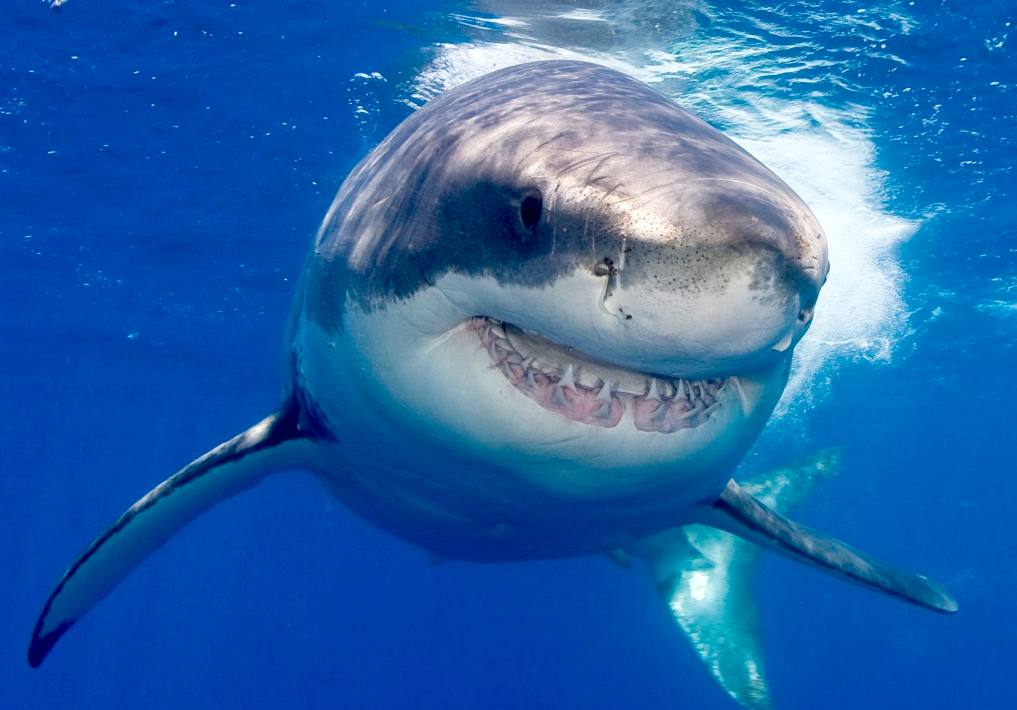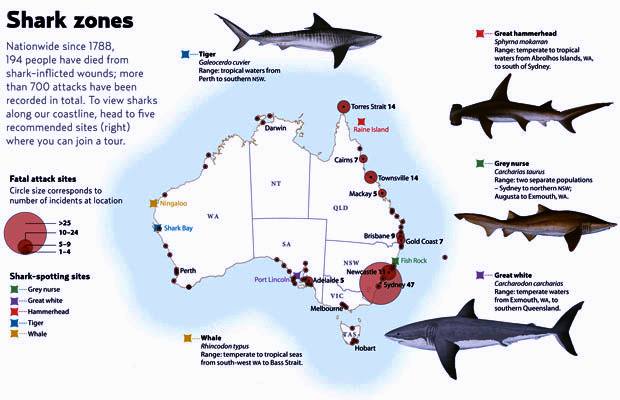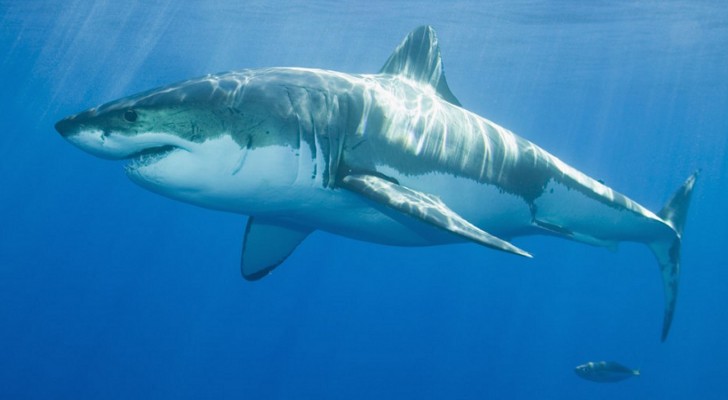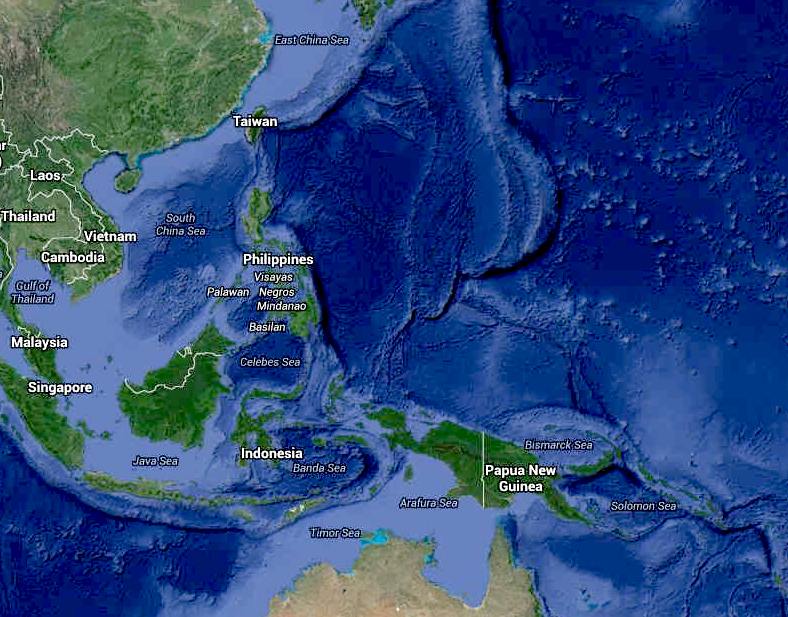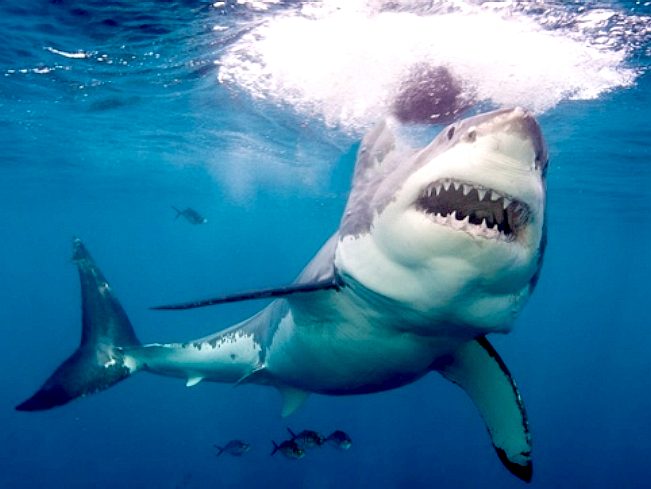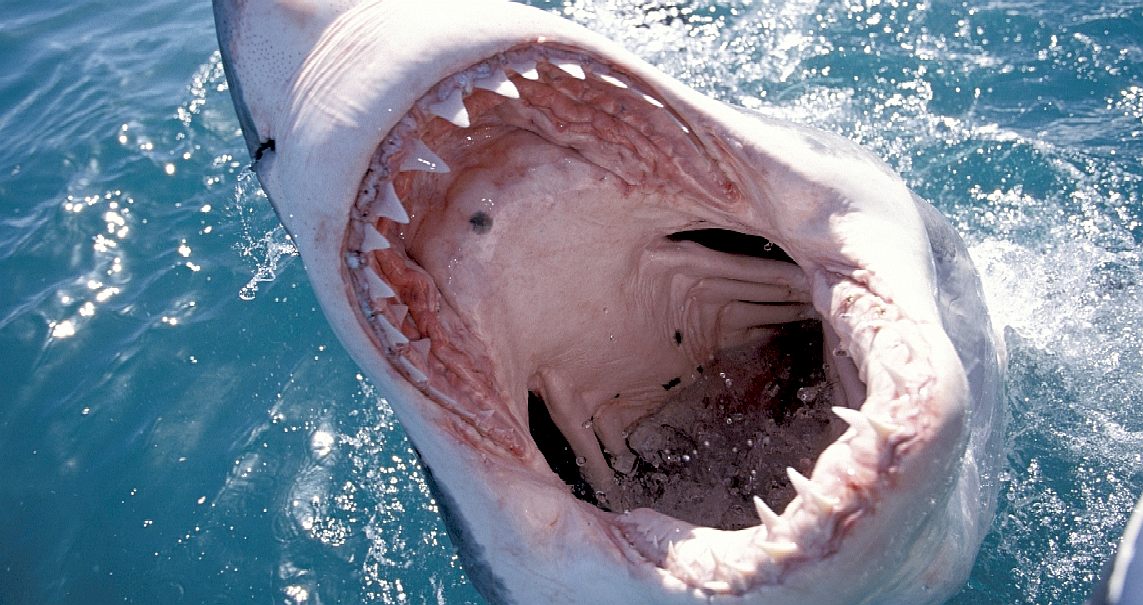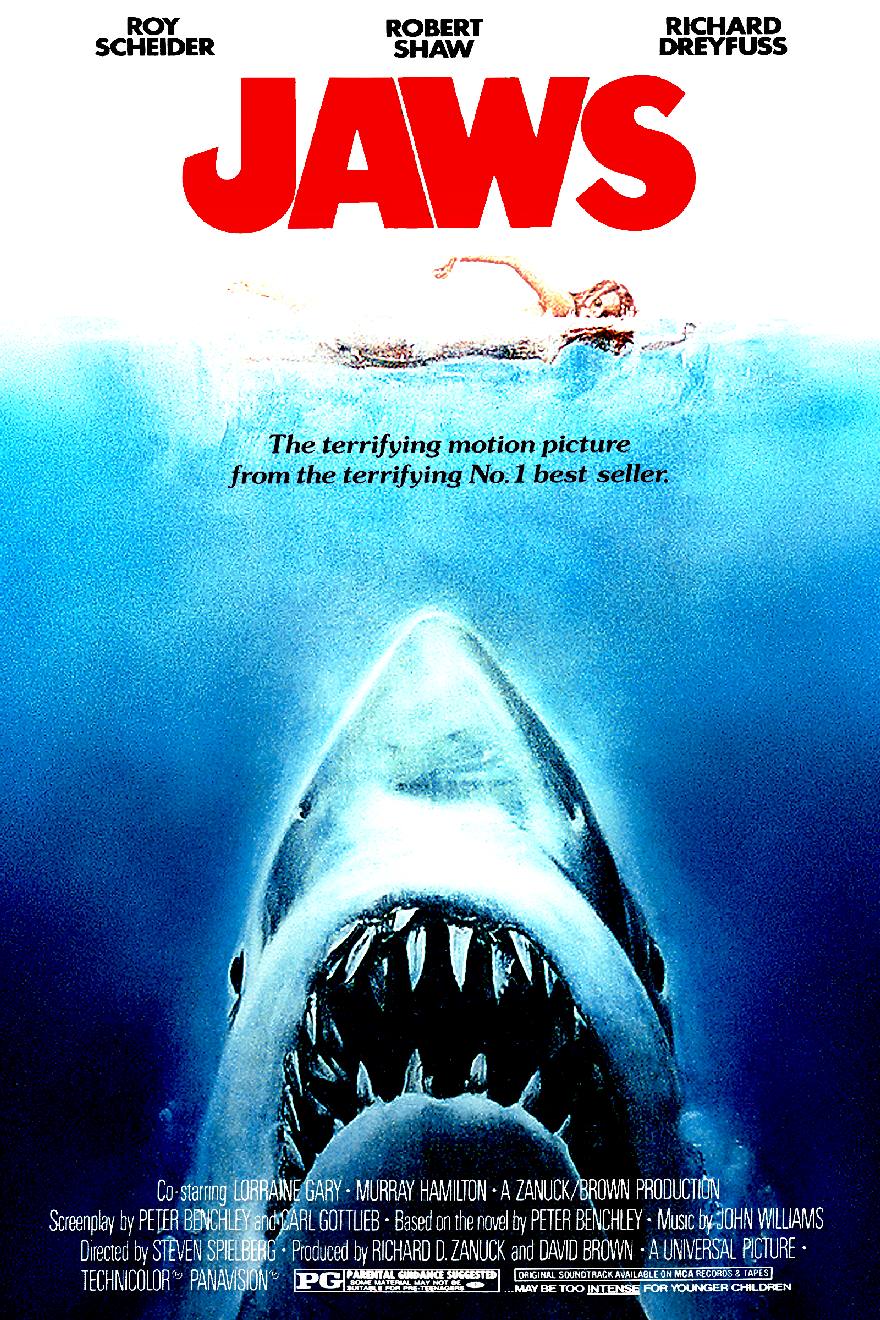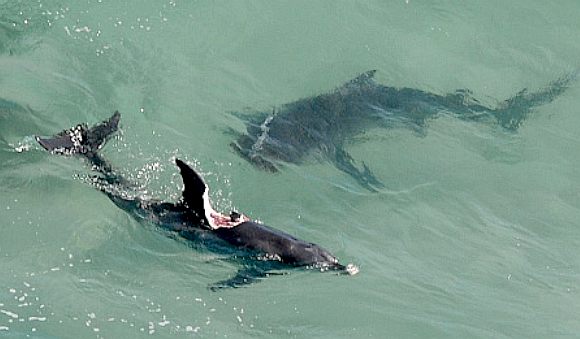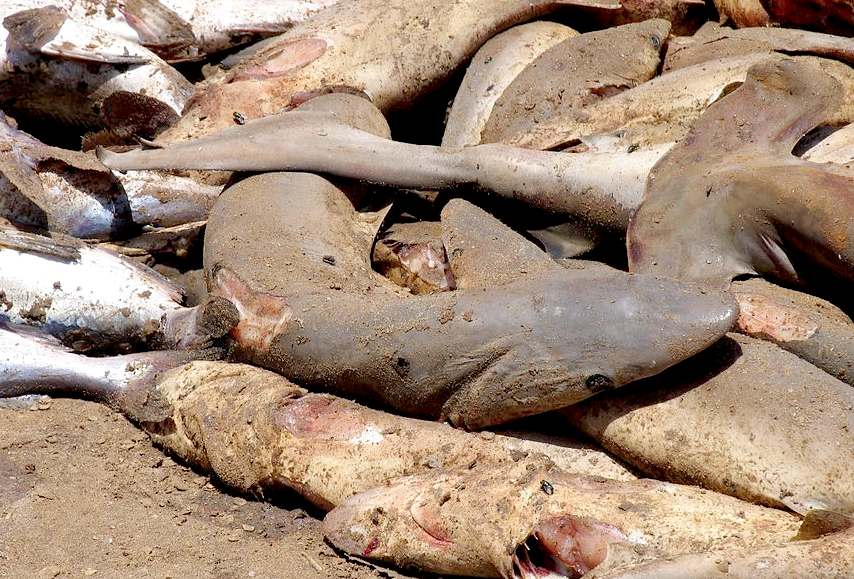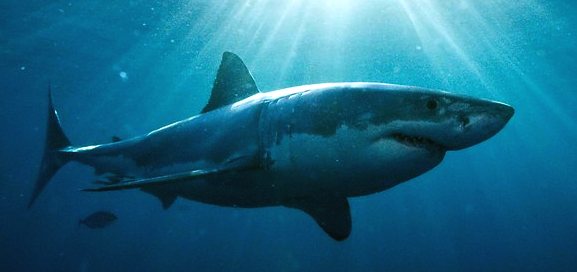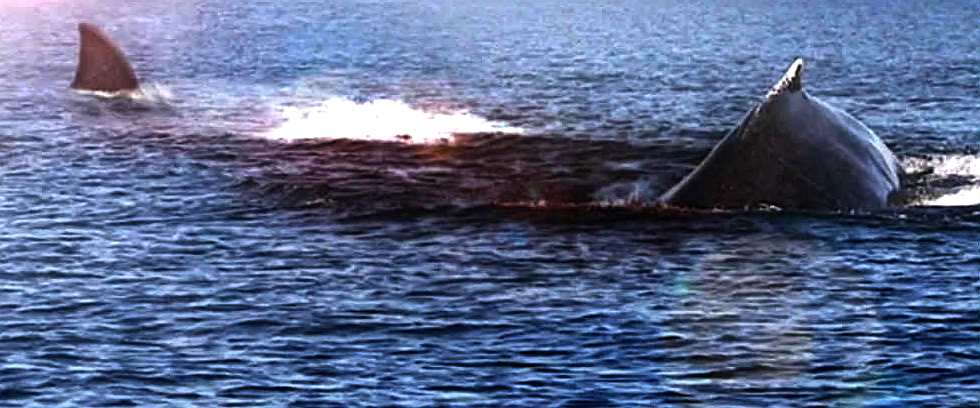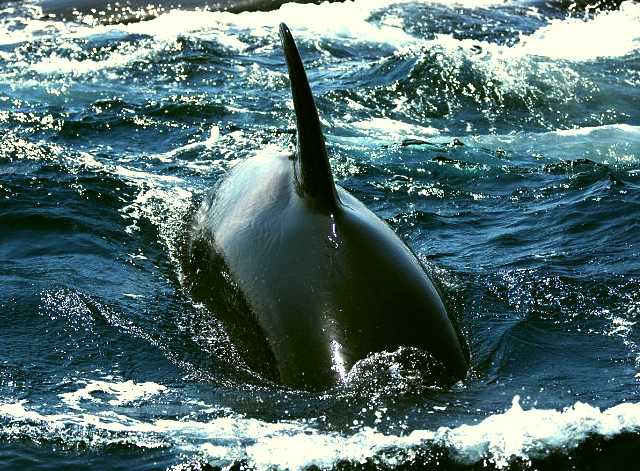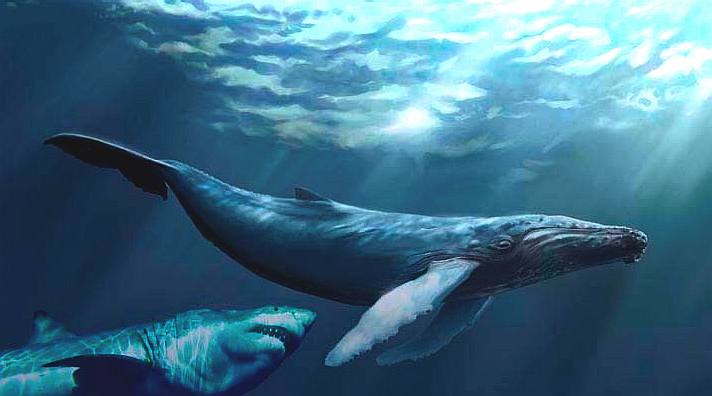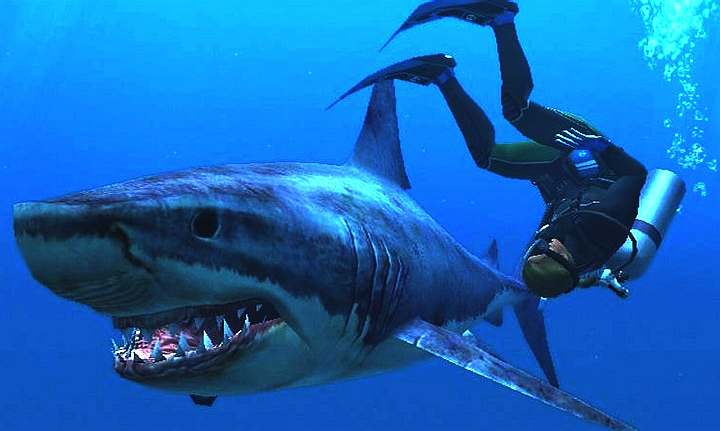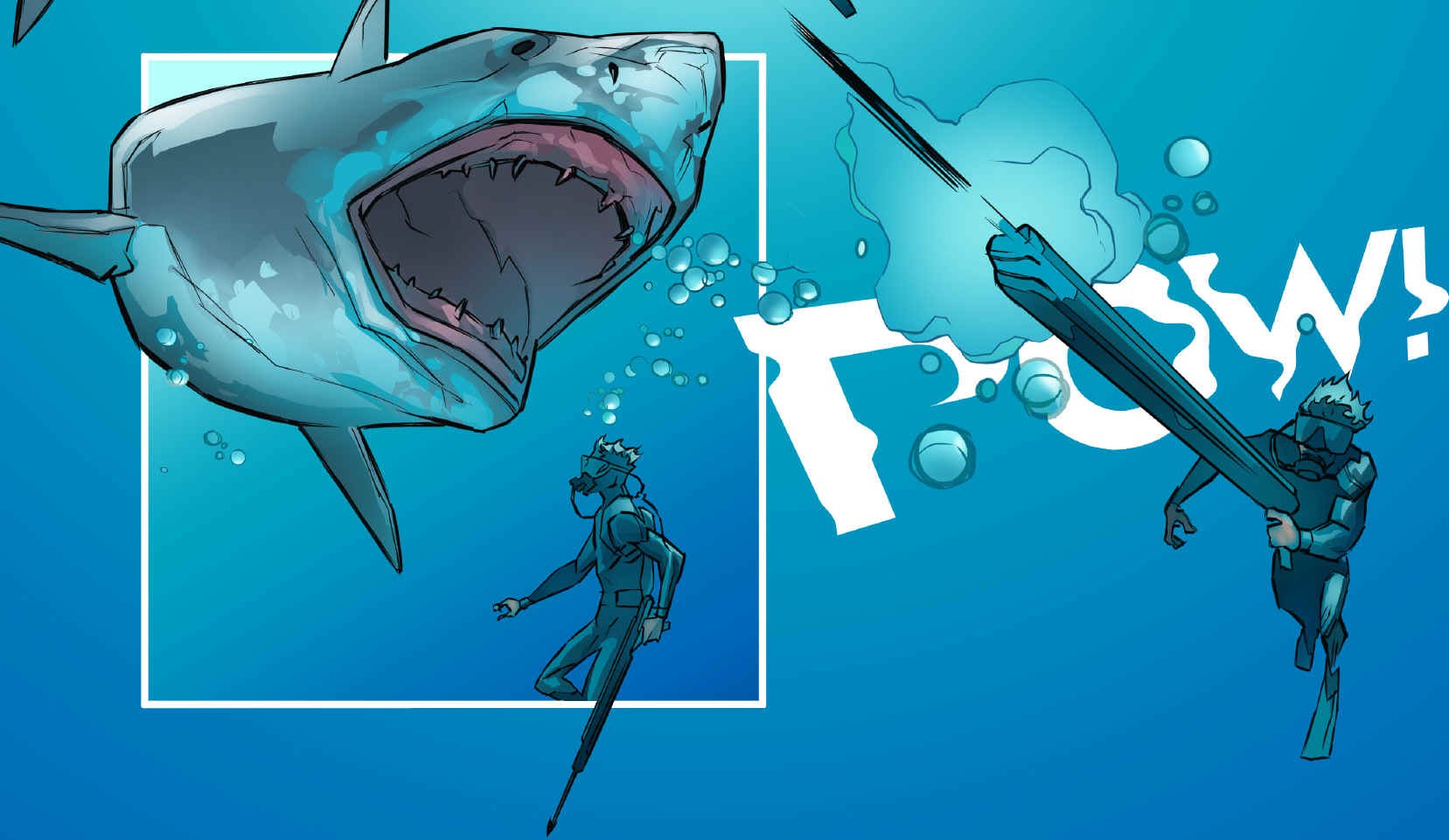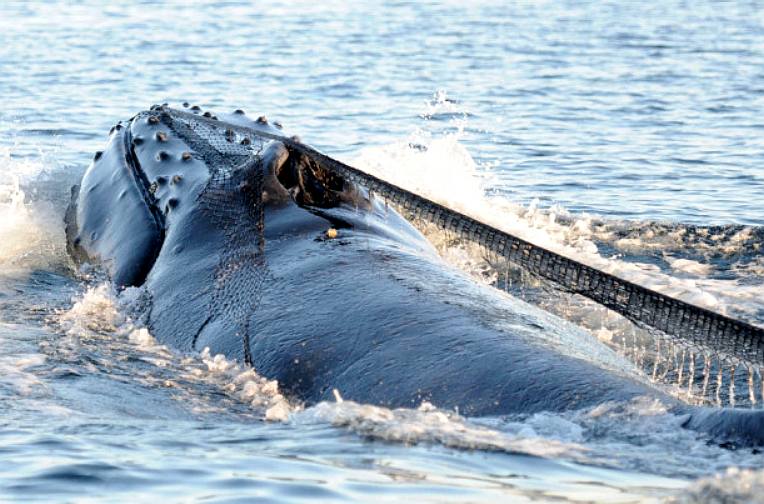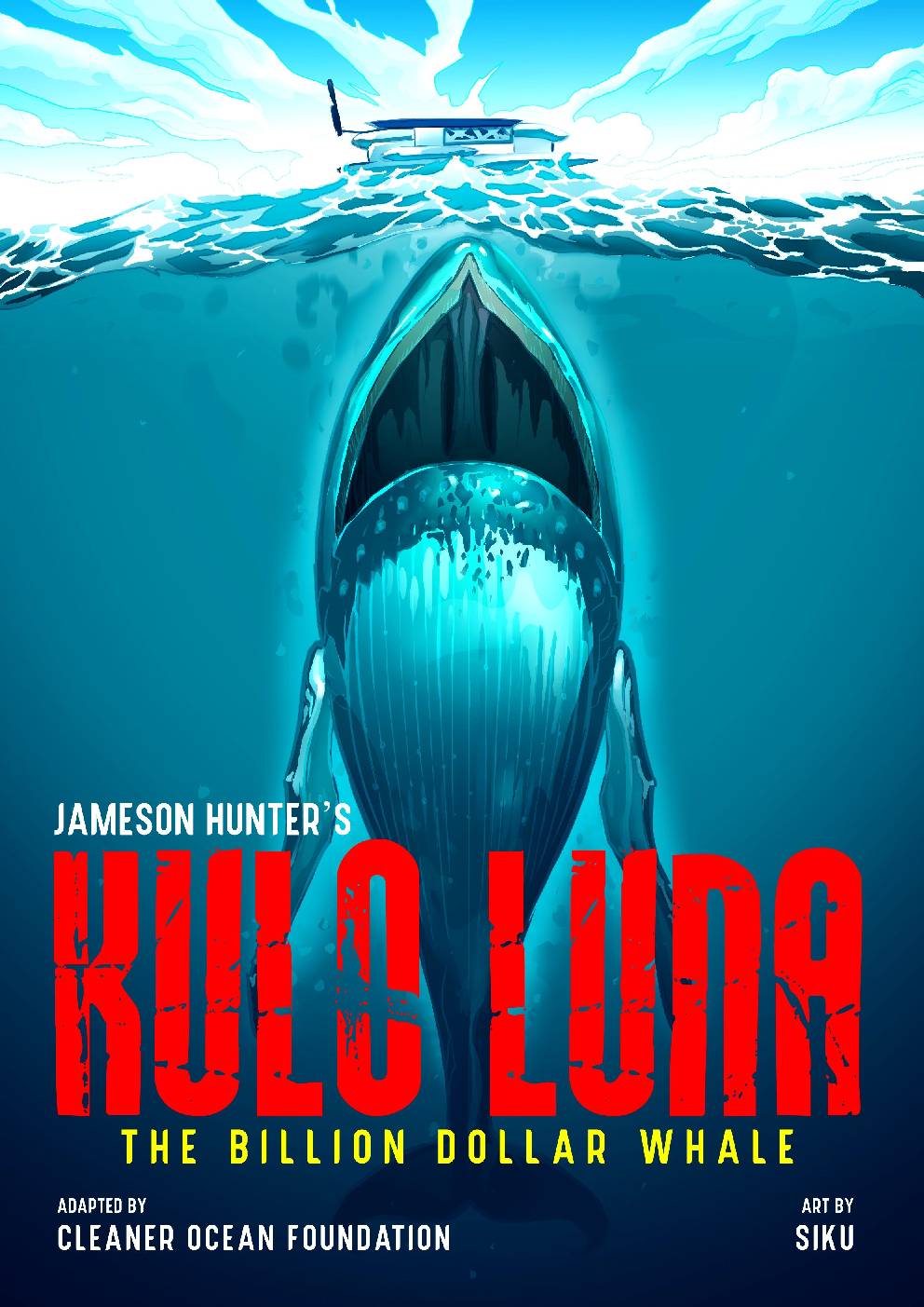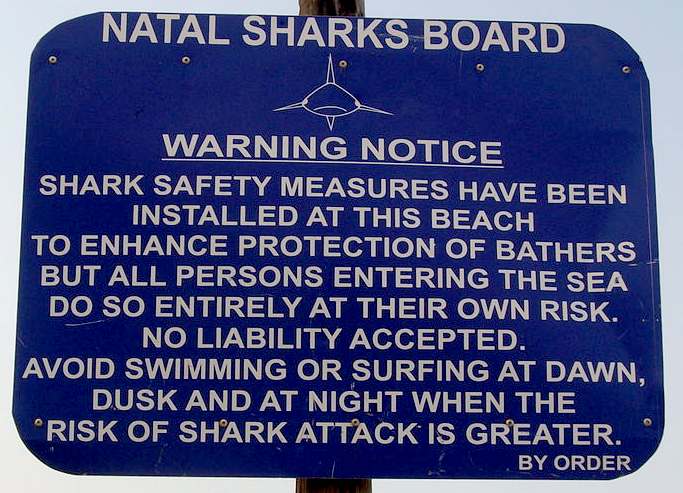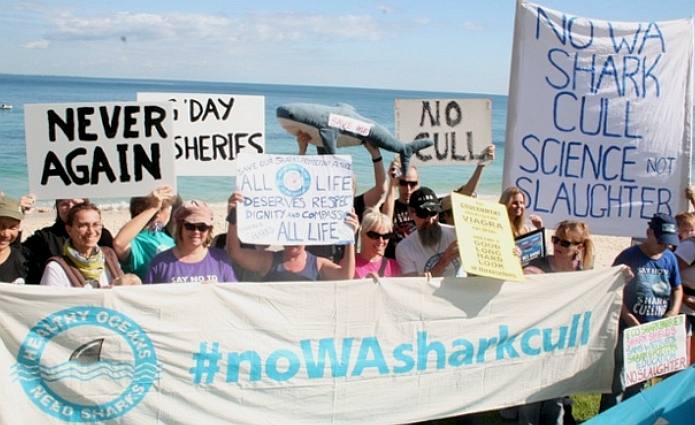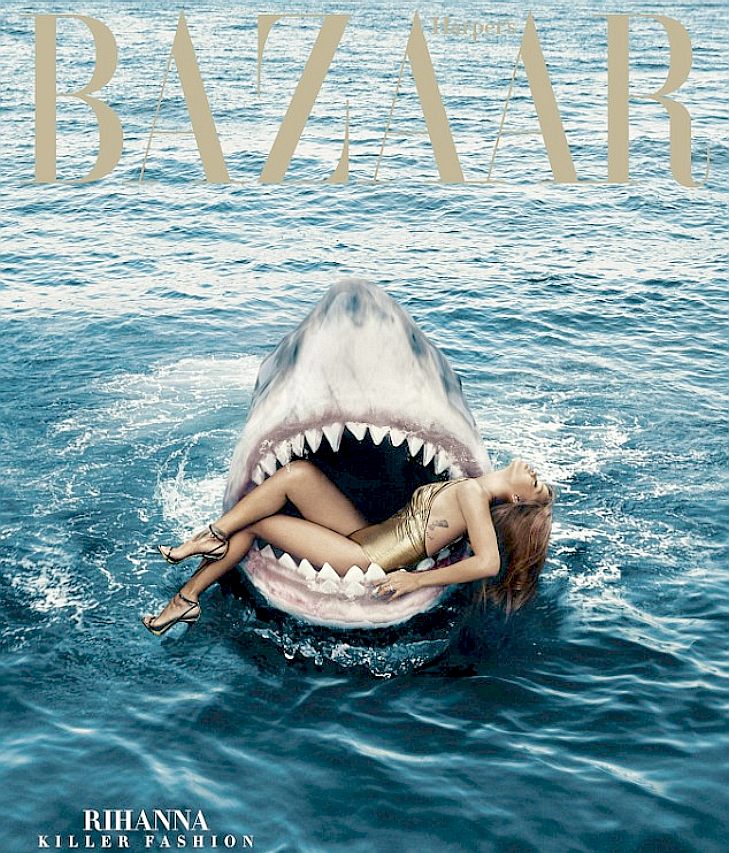|
SHARK ATTACKS - MEDIA REVIEW
$BILLION DOLLAR WHALES | BLUE GROWTH | CONTACTS | EVENTS | KULO LUNA | PIRATE WHALING | ROBOTICS | HOME Please use our A to Z INDEX to navigate this site
|
|||||||||||||||||||||||||||||||||||||||||||||||||||||||||||||||||||||||||||||||||||||||||||||||||||||||||||||||||||||||||||||||||||||||||||||||||||||||||||||||||||||||||||||||||||||||||||||||||||||||||||||||||||||
|
GREAT WHITE SHARK - These magnificent animals bite, but that does not mean we should not protect them. They are the ocean equivalent of Lions in Africa: the top of the food chain and a beautiful fish - but treat with caution.
SOUTH AFRICA, INDEPENDENT ONLINE (IOL) FEBRUARY 2016
South Africa has announced plans for a major expansion of “national parks in the sea”, by creating a new 70,000
km2 network of marine protected areas.
FEAR OF SHARKS
The fear of shark attack is not unnatural in humans who are ill equipped to defend against an attack, but one must bear in mind that fish have to eat to live. They need to eat several times daily, just like us and use more energy to swim the oceans. If you swim about in their restaurant, then you could put yourself on the 'today's special' menu. Put that way, and as we don't have fins or gills, we are the invaders.
Every year around 75 attacks are reported worldwide. Despite their relative rarity, many people fear shark attacks after occasional serial attacks, such as the Jersey Shore shark attacks of 1916, and horror fiction and films such as the Jaws series. Out of more than 480 shark species, only three are responsible for two-digit number of fatal unprovoked attacks on humans: the great white, tiger and bull; however, the oceanic whitetip has probably killed many more castaways, not recorded in the statistics.
THE GUARDIAN 15 JUNE 2015
- US - Two teenagers lose limbs on North Carolina beach
Betty Wallace, Oak Island’s mayor, told CNN that shark attacks are so rare at Oak Island that she could not remember one occurring before the incident this weekend.
THE GUARDIAN JUNE 2014
A controversial $1.28m program to catch and kill sharks off Western Australia's coast should continue for another three years, a state government review has found.
SHARK SANCTUARY, PALAU ISLANDS - Is seen here as a peak in the ocean in the middle of this map. This was the world's first marine sanctuary for sharks from 2009.
BYTES
The New York Times reported in July 2008 that there had been only one fatal attack in the previous year. On average, there are 16 shark attacks per year in the United States with one fatality every two years. Despite these reports, however, the actual number of fatal shark attacks worldwide remains uncertain. For the majority of Third World coastal nations, there exists no method of reporting suspected shark attacks; therefore, losses and fatalities at near-shore or sea there often remain unsolved or unpublicized.
STATISTICS - Contrary to popular belief, only a few sharks are dangerous to humans. Out of more than 480 shark species, only three are responsible for two-digit number of fatal unprovoked attacks on humans: the great white, tiger and bull; however, the oceanic whitetip has probably killed many more castaways, not recorded in the statistics. These sharks, being large, powerful predators, may sometimes attack and kill people; however, they have all been filmed in open water by unprotected divers. The 2010 French film Oceans shows footage of humans swimming next to sharks in the ocean. It is possible that the sharks are able to sense the presence of unnatural elements on or about the divers, such as polyurethane diving suits and air tanks, which may lead them to accept temporary outsiders as more of a curiosity than prey. Uncostumed humans, however, such as those surfboarding, light snorkeling, or swimming, present a much greater area of open meaty flesh to carnivorous shark predators. In addition, the presence of even small traces of blood, recent minor abrasions, cuts, scrapes, or bruises, may convince sharks to attack a human in their environment. Sharks seek out prey through electroreception, sensing the electric fields that are generated by all animals due to the activity of their nerves and muscles.
Australia has the highest number of fatal shark attacks in the world with Western
Australia recently becoming the deadliest place in the world for
shark
attacks, which has also prompted a shark cull by state authorities (later scrapped due to public outrage). However, less than one in every three million
scuba dives in Western Australia result in a fatal shark attack. Australia and South Africa's fatality rate for shark attacks is approximately 30 percent. The United States has the highest reported number of shark attacks but has the lowest fatality rate with around 4 percent of those attacked dying. The United States has had a total of 1,085 attacks (44 fatal) during the past 342 years (1670–2012). According to the ISAF, the states in the U.S. where the most attacks have occurred in are
Florida, Hawaii,
California, Texas, and the Carolinas, though attacks have occurred in almost every coastal state. South Africa has a high number of shark attacks along with a high fatality rate of 27 percent.
THE GUARDIAN 30 MARCH 2015
- WA great white shark killing policy will not be
reviewed
Vogel told Guardian Australia MacLaren’s referral was not valid because the serious threat policy did not qualify as a “significant proposal” under the Environmental Protection Act.
MacLaren said she disagreed with the rejection and would seek a meeting with Vogel.
Steven Spielberg cut his teeth on the meaty role Jaws presented, directing a film using a giant rubber shark model, that simply would not work. Oddly enough, having to resort to Alfred Hitchcock like suspense building, in not showing 'Bruce,' as the flawed animatronic became known, the lack of props actually helped to make the film a success.
JANUARY 2015 - A dolphin with a chunk of its body missing after an attack by an eleven-foot shark has been captured in graphic photographs in the Australian city of Newcastle, where beaches remain closed for a record seventh day due to continued sightings of a growing group of deadly sharks.
DOLPHINS PROTECTING HUMANS
There are documented instances of dolphins protecting humans from shark attacks, such as one attack on a surfer in northern California in August 2007 and one off the coast of New Zealand in 2004. There is no accepted explanation for this behavior; as mentioned in the Journal of Zoology, "The importance of interactions between sharks and cetaceans has been a subject of much conjecture, but few studies have addressed these interactions". In some cases, sharks have been seen attacking, or trying to attack dolphins. The presence of porpoises does not indicate the absence of sharks as both eat the same food.
SHARK FIN SOUP - Although we live on land, we are not detached from it. 71% of the Earth’s surface is covered by ocean. Oceans contain 99% of the Earth’s living space and a huge amount of biodiversity. Scientists believe that there are approximately 240,000 marine species. We also rely on the oceans for much of our food. If we do not practice sustainable fishing methods and manage marine resources responsibly, we will leave an impoverished ocean for future generations. The fact that sharks have existed for 400 million years is testament to their success as a top predator and an ocean caretaker. If sharks are doing such a great job looking after the oceans maybe we should make sure that they are able to continue doing it!
SHARK SLAUGHTER FOR FIN SOUP
Shark fin soup is a popular delicacy in China, and is eaten in Chinese restaurants around the world. Peter Knights, executive director of WildAid, said in 2001 that the shark fin trade more than doubled in the prior 15 years.
In Hong Kong restaurants, where the market has traditionally been strong, demand from Hong Kong natives had reportedly dropped in 2006, but this was more than balanced by an increase in demand from the Chinese mainland, as the economic growth of China has put this expensive delicacy within the reach of a growing middle class.
SHARK FIN SOUP - How can any ceremony justify this kind of barbaric slaughter? It appears that the more affluent Chinese society becomes, the more sharks will be butchered. It's hardly an advertisement for Chinese trade. "Buy from China and slaughter a Shark." The problem here is that China provides high quality solar cells and batteries to the world market, a valuable export. The country simply needs to adjust the eating habits of the population via education campaigns. We cannot believe that once the people know where their fins come from, that that will bolster their appetite for a soup that derives its flavor from other ingredients. Anyone remember 'Mock' turtle soup.
Based on information gathered from the Hong Kong trade in fins, the market was estimated in 2004 to be growing by 5% a year. Consumption of shark fin soup has risen dramatically with the middle class becoming more affluent, as Chinese communities around the world enjoy increasing income levels. The high price of the soup means it is often used as a way to impress guests or at celebrations; 58 percent of those questioned in the WWF survey said they ate the soup at a celebration or gathering.
By late 2013, however, a report in The Washington Post indicated that shark fin soup was no longer seen as fashionable in China. The movement against shark fin soup began in 2006, when WildAid enlisted Chinese basketball star Yao Ming as the front person for a public relations campaign against the dish. The campaign was taken up by a coalition of Chinese businessmen, celebrities, and students, and began bearing fruit in 2012, when China passed a ban on shark fin imports. In January 2013, China Daily reported that officials in Zhejiang province found that many shark fin soup restaurants were selling artificial shark fins, and that one-third of the samples that the officials had obtained contained dangerous amounts of cadmium and methylmercury.
Within two months of the China Daily report, China ordered officials throughout the country to stop serving dishes made from protected wildlife at official banquets, and in September, the Hong Kong government issued a similar order. According to WildAid, consumption of shark fin soup in China has dropped by 50 to 70 percent since 2011. China's commerce ministry indicated that consumption of shark fin soup during the 2013 Spring Break holiday had decreased by 70 percent from 2012, and Hong Kong industry groups reported that shark fin imports were down by 20 to 30 percent from 2012. Also, anecdotal evidence points to a worldwide drop in shark fin prices and a move away from shark fishing in parts of Africa.
SHARK FIN SOUP - Any country that is guilty of such waste, should have their fishing quotas cut, along with allowed exports. It would not be such a crime if the whole shark was utilized for food in a sustainable manner. This is surely a case for an alternative dish that is sustainable: Mock shark fin soup. Where's Jamie Oliver when you need him?
SHARK FIN SOUP BANS
Some groups, such as Fins Attached, Shark Savers, Shark Angels, Shark Whisperer and the Sea Shepherd Conservation Society, discourage the consumption of the soup due to concerns with the world’s shark population and how inhumanely sharks are finned alive and tossed back into the ocean, unable to swim, hunt or survive. The prevalence of shark finning and the sustainability of sharks are both debated. Others feel targeting the Chinese tradition is Sinophobic. Major hotel operators The Peninsula Hotels and Shangri-La Hotels and Resorts stopped serving shark fin soup in the interest of offering sustainable seafood. The three largest supermarket chains in Singapore - Cold Storage, NTUC FairPrice and Carrefour—have stopped selling shark fins while also citing sustainability concerns. Hong Kong Disneyland dropped the soup from its menu after it could not find a sustainable source. The University of Hong Kong banned serving shark fin soup, hoping "to give a lead which others in Hong Kong will follow".
Chapter 28 - SHARK ATTACK 1640 E, 80 N (extract from: The $Billion Dollar Whale by Jameson Hunter © 2014)
Visibility
was excellent and the sea was state three on the Beaufort scale – just a
light breeze for hardened mariners. The sun was readying to settle after a
glorious day’s sailing, sinking slowly into the horizon. Solar Navigator
had covered 150 nautical miles since sun up, cruising fast at 18.75 knots,
her low drag hull cutting through the deep blue Pacific water with
consummate ease.
“Skipper,”
said Dan, over the tannoy, “according to the log, we’ve covered 2,000
miles since leaving Honolulu Harbour.” “Great,
that’s 200 miles a day. We’d be way in the lead.” John
knew what Dan would be thinking. He’d joined the project to prove solar
technology, not rescue a whale. In the background, John could hear the radio
broadcasting the latest race positions and speculation as to the missing
race leader. Starlight was now in the lead. John wondered again what Sarah was up
to? He gave in. “Navigator
to Starlight, come back Starlight.” …… Silence and some crackles….. “Navigator
to Starlight, over.” Silence…. “Dan, switch to autopilot and take her down to 5 knots on batteries. Oh, and lift the boom manually - when the sun disappears. Cheers.” The
radio crackled into life. “Hello John, this is Starlight, caught any good
fish?” “Hi
Sarah. Just heard the race update, thought we’d offer our congratulations
- well done. Over.” “Never
mind that, how’s the search going? Over.” “Not
a jot, keep in touch. Over.” “Okay
big boy, we’re all thinking of you. Mum’s the word, out.” Dan
was keeping a sharp lookout from the Com, while John scoured the horizon
with renewed vigour through powerful Karl Zeiss binoculars, straining for
every last detail which might resemble a whale. After
another 20 minutes John blasted, “Dan, you still awake?” “Yuuup,”
he said involuntarily snapping back to attention, “but this chair sure is
comfy, any chance of a brew?” John
smiled to himself. He was feeling slightly jaded also and the chairs upfront
were exceptionally comfortable. “Okay, I’ll sort some liquid. You keep
at it.” John
hung his spyglasses up and deftly swung into the cabin below. After a
whirlwind galley brew, for which he was famous, he delivered a cup to Dan.
“Offf,” he sighed, collapsing into the soft white leather chair next to
Dan. John took two sips then sat upright again. He focused on the
instruments for a moment. Nothing was showing. “We
won’t find anything chatting,” he said suddenly, and with that he spun
himself out of the chair and off he strode to the aft helm. Coffee
mug firmly located in a gimballed holder and spyglasses snugly pressed
against his brows, John scanned left and right, then right and left. He
checked the compass bearing – west, south west.
“Dan,
any thoughts on position? We should have sighted the whale long ago by my
reckoning.” “It’s
the old needle in the haystack problem. It’s a large ocean Skip.” John
climbed onto the solar decking for a better angle. The light was just
perfect for spotting unusual surface activity on the horizon. There was a
dark patch to the left. “Dan,
look on the sonar, steer 15 degrees to port.” John
strained hard, looking at the small patch which was now dead ahead and
closing to 1200 metres. He swore he could see the patch moving and rubbed
his eyes. His skin prickled. Dan came over the tannoy. “John, this is weird, the sonar shows
several small blips.” Both men were now straining for detail. Two intense
minutes ticked by. “700
metres and closing.” Another
minute passed. “400
metres.” John could now see movement on the surface, the unmistakable darting of shark fins, circling the dark patch. An icy shudder passed through him. The great white shark (Carcharodon carcharias) is one of the most beautifully adapted predators in the ocean with a kill rate of some 50%. It is the most efficient and most feared big fish. They can smell blood in the water at just one part in a million. They’ve been swimming the oceans for millions of years virtually unchanged, their streamlined shape near perfection. They migrate across the oceans for up to 7,000 kilometres, to take advantage of known food sources, such as seals. With an impressive 70% of muscle, special drag reducing scales and a heat exchange conservation system that allows them to keep their blood 140 warmer than other sharks, they can attack prey at phenomenal speeds for short duration. An
array of electrical sensors around their open mouths enables the white shark
to see the electrical fields around their prey, with their eyes shut. They
have rows of triangular razor sharp serrated teeth, which allow them to saw
through their food, by shaking their heads violently from side to side,
notoriously depicted in the film Jaws in the opening sequence. Also known as
white death, the great white is the most dangerous to man. The Pacific Ocean
is full of these roving predators on the lookout for their next meal.
Joh n and Dan spotted the humpback whale being circled by great white sharks. It was obvious that they were getting impatient and would soon attack the near motionless mammal. Something had to be done and quickly.
The
wounded humpback had laid a trail in the water betraying its course; the
smell of blood in the water had drawn several great whites from miles around
to the possibility of an easy meal. It
looked as though the only reason the sharks hesitated was that the whale was still obviously
mobile and a well aimed blow from its huge flippers, was potentially dangerous.
They kept their distance looking for the right moment to strike. Time was on
their side, or so the sharks thought. “Dan,
action stations, come aft quickly. Sharks! We might be too late.” Dan
ran along the walkway his deck shoes screeching from the acceleration, then
through the aft module. They were just 300 metres away. Dan took the helm. “Great,”
said John. “200
metres skip and look at all those great whites and the size of that
humpback. It’s huge,” gasped Dan. Four
sharks now circled the humpback whale, another having joined the pack. John rigged up the rear searchlights –
the light was fading. What now, he
thought. John lifted up a seat locker taking out his diving suit and hoped
for inspiration. “Bring
us alongside.” Dan
reduced revolutions, stopped engines and reversed thrust, while swinging the
Navigator skillfully ahead of the whale to port. Blood was in the water. Dan
looked back to see John
suiting up for a dive. “Dan,
make us a big brew and get me a feed from our sound system, with plenty of
cable. The whale’s bleeding badly.” “Done
skip.” John
pulled out a loud-hailer. Hmmm,
… “Okay,
Dan, can you dig out some whale song recordings – old chum.” “Tough
call skip, I’ll try,” came the reply. “Wait a minute, we got some in
Hawaii, didn’t we.” John winked to signify his shipmates catch-up. John
rummaged around for a bin liner or inflatable bed, but instead found an old
Harrods carrier bag. It was nice, thick, quality plastic. That’ll
do. He ducked into the galley and came out with two chocolate Mars bars,
which he tucked into his dive pockets. “Dan.”
John
continued to suit up, slung a single cylinder dive pack on his back and
wetted his mask. “Dan,
the sharks are getting kinda hungry.” John
pulled a spear gun from another seat locker, along with six spears, which he
clipped onto his backpack. Dan came out with a coiled cable. “Here
skip, tie these on.” He
rushed back inside. John bared the cable ends and pried the back cover from
the loud-hailer, pulling the wires from the speaker coil carefully. He
twisted the new cable ends to the coil one at a time, then went back into
the locker for some insulating tape and a reel of gaffer tape. Then he taped
the wires to insulate them, and stretched the Harrods bag over the speaker
end, winding the rim with the gaffer tape several times, and tearing the tape
with his teeth. Classical music suddenly drifted up from the galley
speakers, followed by singing whales. “Ready
when you are skip.” John
had already lifted the deck hatch and was half way down the three meters of
steps to the diving platform, when Dan’s face appeared in the hatch frame.
“Get
ready to turn up the music Dan.” “Okay,
should I record on the underwater cams.” “Why
not. Warn me if the sharks get too close,” smirked John. They
both looked across to the circling sharks. John put the megaphone into the
water while still hanging from the boarding rungs. He squeezed the trigger
switch sending a piercing stream of audio beneath the waves. The sharks
began swimming erratically almost immediately, describing a wider circle as if looking away
from the injured whale for other whales, yet still drawn to the smell of blood. The songs
continued playing disorienting the sharks, at the same time the whale began
to move energetically. John entered the water spear-gun in hand. This was going to be dangerous, he thought, as he went under. Now he
could hear the singing. One inquisitive shark headed straight toward him.
John faced up to the inquisitive great white shark, drawing blood from the huge fish with the tip of a spear gun. The other three sharks abandoned their meal with all the confusion.
“Look
out Skip,” said Dan through the loudhailer. John
braced himself, head to head with a great white before bunk time was not his
idea of fun. He pointed the spear-gun at the shark without flinching, ready
to fire if need be. The
shark came straight for him mouth closed but veered off at the last minute,
rubbing his sandpaper like scales against the sharp tip of the spear, which
drew blood from the shark and must have hurt. Dan
turned the volume up full blast, which seemed to send three of the great
whites swimming off in different directions. More agitated than before, the
injured shark again swum for John, this time mouth wide open and head back
in that famous toothy grin, revealing the full magnificence of the rows of
deadly triangular serrated teeth. John fired a warning shot which the shark
felt with its mouth sensors and took evasive action. John was loath to harm
even a shark, if unnecessary. He quickly reloaded and braced himself for
another pass. Dan
was watching in disbelief. He’d seen quite a few TV documentaries about
shark attacks, but never imagined he’d witness a close encounter first
hand. John leapt out of the water in a surge of white froth.
John Storm faces off four great white sharks, bravely challenging them to take a bite out of him, armed with only a speargun, a megaphone and a plan to save a humpback whale trapped in fishing nets.
“Dan
can you hear me?” “Yo
skip.” “I
grazed that first one. That was too close for comfort. I’m gonna take a
look at the whale’s wound. Can you grab
all our medical supplies and put them on the galley table.” “Going
in again now? You must be crazy” “Got
no choice.” “Okay
skippa.” Dan still thought he was crazy. He had visions of John being
bitten in two, followed by a feeding frenzy. He was seriously worried,
almost in shock himself. Adrenaline coursed through his body. He wondered
what John must be experiencing. Dan climbed down and handed
John a thermal mug, keeping a watchful eye on the sea, as he did so he
remembered that the blood from a great white frightens other sharks away,
including great whites. “Cheers bud,” said John taking a few gulps of hot fluid, then headed back into the water. Keeping a weather eye open for return of any triangular toothed opportunists, John swam over to the whale, somewhat wary in case the animal decided that he was unwelcome. The whale had stopped its agitated movement, as it watched the great whites swim off, noting the bravery of the human with strange twin flippers and metal cylinder on its back that breathed noisily at regular intervals. John swam, around the magnificent creature, looking for signs of injury, and there was some grazing down one side of its body. The
whale was tangled in a mass of fishing gear, ropes and nets. They'd not
noticed that before because most of it was submerged. Then he spotted the slice wound just
behind the whales spout, before its dorsal fin. It was a serious looking
gash about a meter in length, where the harpoon had glanced off, slicing
through about 600 millimetres of flesh as it went. Blood was escaping at
quite a rate. You were lucky my beauty, thought John to himself.
Modern harpoons explode once embedded, thanks to Sven Foyn, a Norwegian whaling captain, who invented these lethal weapons in 1864. If the harpoon had found its target and exploded, this whale would now be sushi. The back wound was bad enough, but the fishing nets had the potential to do far more damage, tiring the whale out and reducing transit efficiency. Hundreds of whales, seals, turtles and even sharks drown each year from discarded fishing gear. John had known about this problem but not seen it for himself. The sudden impact of the problem made his blood boil. He imagined how awful an intelligent creature like a whale must feel once entangled and helpless.
John took out his knife and began cutting the fishing net from the whale. Working slowly so as not to distress the animal more than necessary he worked his way back to the tail, almost getting himself caught up more than once. He mused to himself, it was that easy to fall foul of these floating traps. That's fine for a diver with a sharp knife. For a helpless animal with flippers, it is like a hangman waiting around every corner. As each section of the net was cut away John patted the whale, speaking to it. "There, there. Not long now." As each rope was cut off John felt as though he was almost freeing himself, it was a challenge. The whale could feel the ropes falling away and moved its body in appreciation, pushing against John and forcing him sideways at quite a rate. "Good whale, stay still now." He waited for the animal to stop moving before resuming the rescue. He didn't mind the fidgeting, he'd probably do the same. The whale must have read his thoughts, stopping to allow the remaining ropes to be cut away. It knew this was a rescue and John sensed that it knew. So John worked even harder, trying to suppress his excitement and remain focused. The ropes and nets were coming away in larger sections until finally they were gone. The whale felt this also and gave out a loud below: whoooh oooohhhhaaaa. That made John laugh out loud into his mask. Then the whale cleared its throat with a huge breath and spout of water, like a small fireworks display - and thrashed its tail. John swam back along the whales body, until ahead of a giant mottled white flipper, which he held gently for a moment expecting a backlash that never came, then John propelled himself forward meeting with the whale's left eye. The eye seemed to follow him, blinking twice. John sensed the animal studying him appreciatively. He looked deep into the dark blue retina and the whale looked back into John’s hazel eyes. John put both hands around the whale’s eye and smiled. He wasn’t sure the whale could focus this close up, but it signaled back with a deep oooohh aahhh eeee, the vibrations of which went right through John's body. Some people believe that whales can communicate telepathically and some humans have the ability to put animals at ease. Whatever it was, John instinctively hummed back, mimicking the whale’s signal. The intelligent creature flapped its tail softly. The pair had made contact, an understanding of sorts. John surfaced again. He knew he’d have to make some kind of temporary bandage to stem the blood loss. He quickly climbed up the Navigator’s lowered diving platform, going into the galley. “There’s a gash about a metre long, we’ll have to make a makeshift bandage, then try to get some professional help.” Dan nodded. “The sharks have bunked off. I think the blood from the one you wounded did the trick.” “Of course,” replied John. "You should have seen the nets. No wonder the sharks were waiting. Another day and the whale would have drowned anyway. No risk to them then." John pulled off several one and a half meter strips of an especially sticky reinforced general purpose tape, which came in reels 200mm wide for emergency hull repairs. He lapped one over the other at the edges by about 50mm, until he’d achieved a width of some 400mm. He repeated this making two bandages. Then he rummaged about in the cupboards, coming out with a roll of greaseproof paper, which he unrolled over the upward facing adhesive patch, tore off, then rolled up the patch, securing it temporarily with an elastic band that was handy in a draw. “Nice one skip.” John winked back. “What antibiotics have we got,” said John hopefully. “You must be joking, Dan replied.” Both men were now thinking hard. They carried a medical chest, but on this scale, nothing was suitable. Two rolls of lint were then unfolded and two tubes of Germoline squeezed onto one surface, then the other lint strip laid over the top to make a soft cream sandwich. This too was rolled up. "Okay, that's the bandages but they will soon come adrift. We need a sheet and some rope." John looked at Dan for feedback. None came. Instead, Dan went forward and pulled up his bunk. John following Dan's lead rummaged in a storage locker for some thin coiled rope. The two men met with a smile in the rear cockpit, Dan brandishing a sheet and John some rope. There was no need to speak. John began reeling out the rope. "What do you think, 6 meter lengths." "Plenty." replied Dan. John cut four lengths, which Dan tied to each corner of his sheet. They then folded the sheet neatly and wound the rope ends around it. “I need a bag with a strap,” said John raising his eyebrows. Dan went into his cabin and came back with a large nylon fabric computer case covered in bright graphics, still emptying the pockets of accessories. It had a long strap. “That’ll do, ta.” "The sacrifices I’ve made for this project.” He was only joking. “Thanks Dan, I’ll make it up to you.” “Don’t be daft,” said Dan grinning, “anything to help a whale in distress.” But John knew Dan was fond of this case. He adjusted the strap to full length and put it over his left shoulder. Then he put the rolled up sheet into the base, and the two bandage rolls on top, which just accommodated the first aid adequately. “Keep a sharp lookout will you - just in case,” said John, checking his air contents gauge, as he exited the galley and disappeared down the platform steps, stopping for a few seconds for a scan of the horizon to check the ocean for danger, before jumping into the briny. Even though he knew about the shark blood theory, one can’t be too careful. The bubbles dissipated as John surfaced and headed to the whale, now floating still on the surface, sucking air and exhaling noisily every now and then. John duck dived to the left eye, again making visual contact for about twenty seconds. He pointed to the bag, holding it up, as if asking for permission to proceed, then pointed to the whale’s back. The whale breathed noisily like a patient in a hospital that knew treatment would hurt, but making no effort to stop John. He took his chances laughing inwardly at the sounds coming from the animal. He flippered up to the whales fin and climbed onto it, then carefully pulled himself onto the whales back well behind the hemorrhaging gash, using the fin as a step. The whale remained immobile, which he took as a sign that it was safe to proceed. The wound looked angry and painful, though it was a clean cut, it was still bleeding profusely, which made him shudder. He had no time to check the wound. John took out the first rolled up bandage and laid it out sticky side up for size. It covered the full length of the injury with about twenty centimeters on either side. Two bandages overlapping would be only just wide enough. He flipped the bandage and applied it to one side of the wound, at which point the whale let out a wail of pain and thrashed its tail and flippers. “Steady boy.” John patted the whale making soothing noises. Without hesitation he then unrolled the second bandaged and applied it quickly, just in case the whale turned. Once again the whale let out a low groan, then as the soothing cream got to work, it stopped its movements and trumpeted an involuntary sigh. John gently smoothed the overlap and edges, talking all the while to reassure the lone animal he meant no harm. These gestures might have seemed insignificant but the end result was that the whale had decided that this human was a friend. Now came the tricky part, John pulled out the rolled up sheet and uncoiled the rope ends. He laid the sheet over the center of the bandaged wound and unrolled it to left and to right until two rope ends dangled down on either side of the whale. He then dived into the sea and grabbed the ropes on one side, swimming to meet the two ropes dangling on the other side. He then looped the ropes together under the whales throat to make a knot, pulling as hard as he dared without distressing the whale. "Hold in there buddy," said John to the whale as he again climbed the whale's flipper to check the sheet had not slipped. He gently scrambled onto the whales back. Miraculously, the sheet had stayed in place over the bandage, making it look secure - but for how long. It looked for all the world like the whale was wearing a scarf. John dismounted and swam back down to the whale’s eye and waved. He then grasped the huge white and grey patterned flipper in both hands and rubbed it, which was the closest he could come to shaking hands. The whale seemed to respond with a short but tuneful blast, then groaned again long and wistfully. John knew the whale was not well. They needed an expert and quickly.
- * -
ACIDIFICATION - ADRIATIC - ARCTIC - ATLANTIC - BALTIC - BAY BENGAL - BERING - CARIBBEAN - CORAL - EAST CHINA ENGLISH CH - GOC - GULF GUINEA - GULF MEXICO - INDIAN - IOC - IRC - MEDITERRANEAN - NORTH SEA - PACIFIC - PERSIAN GULF - SEA JAPAN STH
CHINA - PLASTIC
- PLANKTON - PLASTIC
OCEANS - SEA
LEVEL RISE - UNCLOS
- UNEP
WOC
- WWF AMAZON - BURIGANGA - CITARUM - CONGO - CUYAHOGA - GANGES - IRTYSH - JORDAN - LENA - MANTANZA-RIACHUELO MARILAO
- MEKONG - MISSISSIPPI - NIGER - NILE - PARANA - PASIG - SARNO - THAMES
- YANGTZE - YAMUNA - YELLOW
LINKS & REFERENCE
Theguardian US news June 2015 shark attacks two teenagers lose limbs on same north carolina beach The Guardian environment 2015 March WA shark policy killing great whites not reviewed http://www.theguardian.com/us-news/2015/jun/15/us-shark-attacks-two-teenagers-lose-limbs-on-same-north-carolina-beach http://www.theguardian.com/environment/2015/mar/31/wa-shark-policy-killing-great-whites-not-reviewed http://www.iol.co.za/capetimes/more-protection-for-countrys-ocean-zones-1991007 http://www.iol.co.za/capetimes/more-protection-for-countrys-ocean-zones-1991007 http://en.wikipedia.org/wiki/Shark_attack The Telegraph Shark-attacks-teenager-off-Australian-beach http://www.dimdex.com/en/warship-display.aspx http://en.wikipedia.org/wiki/Shark_fin_soup http://www.asdwire.com/press-release-8988/ http://www.maritimeaustralia.com.au/ http://www.pacific2013.com.au/innovation-awards/index.html Kestrel
Marine's Sentient object recognition
system
WA
PROTESTORS -
Western Australia is the scene of several protests against the authorities
plans to keep on killing sharks using methods that are objectionable.
KILLER
FASHION - Rihanna sits in the mouth of a massive great white shark as she pays tribute to Jaws in Harper's Bazaar bikini cover shoot. The photo is inspired by
Steven
Spielberg's 1975 film Jaws, which sees a similar animatronic great white stick its head out of the water.
Riana's "Work," featuring Drake, spends a second week at No. 1 on the Billboard Hot 100 (dated March 12), vaulting in streaming following the Feb. 22 premiere of its official video.
|
|||||||||||||||||||||||||||||||||||||||||||||||||||||||||||||||||||||||||||||||||||||||||||||||||||||||||||||||||||||||||||||||||||||||||||||||||||||||||||||||||||||||||||||||||||||||||||||||||||||||||||||||||||||
|
This website is Copyright © 2021 Bluebird Marine Systems Limited. The names Bluebird, Bluefish, Miss Ocean™, RiverVax™, SeaNet™, SeaVax™, and the blue bird and fish n flight logo are trademarks. All other trademarks are hereby acknowledged.
|
|||||||||||||||||||||||||||||||||||||||||||||||||||||||||||||||||||||||||||||||||||||||||||||||||||||||||||||||||||||||||||||||||||||||||||||||||||||||||||||||||||||||||||||||||||||||||||||||||||||||||||||||||||||
